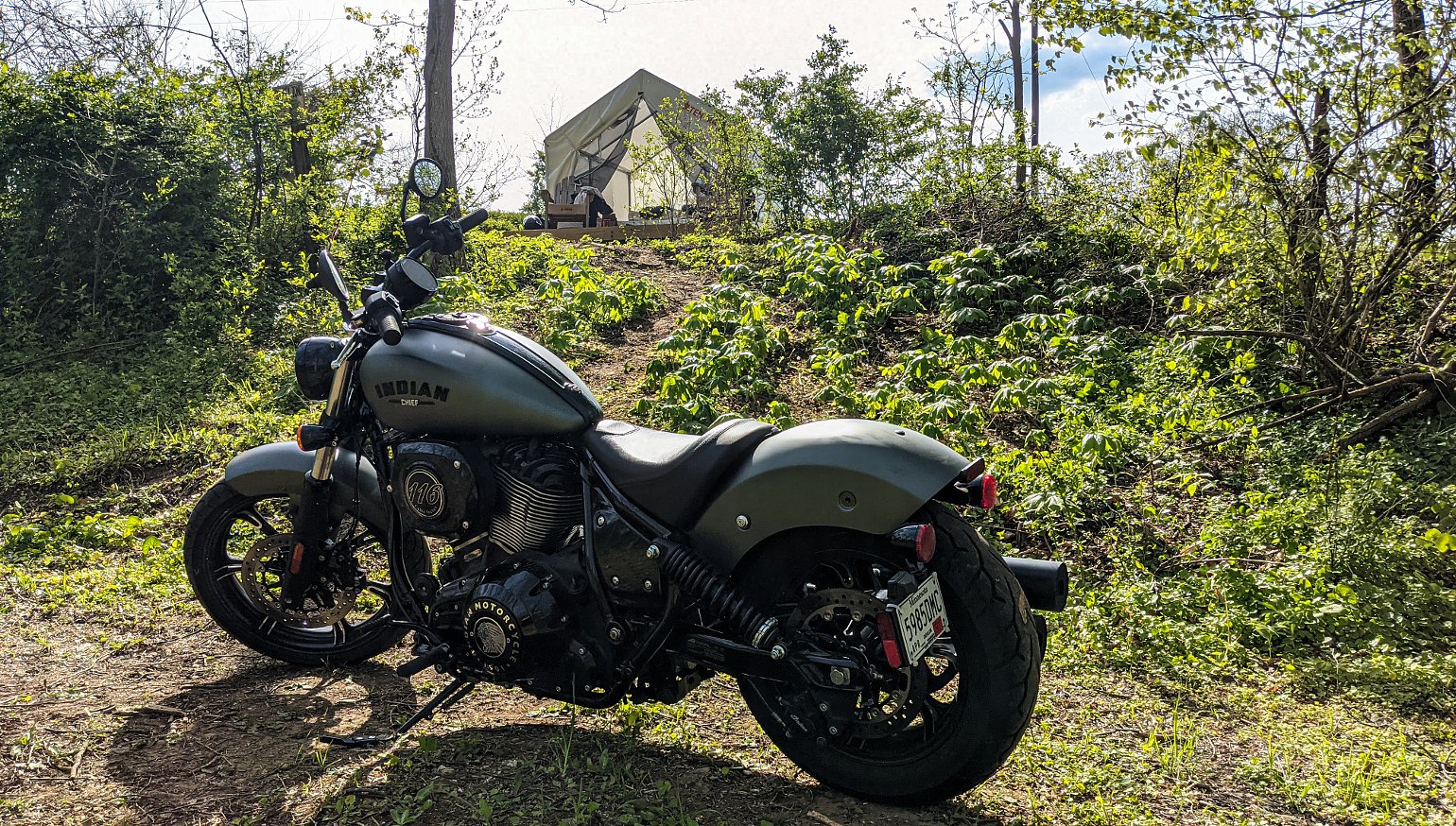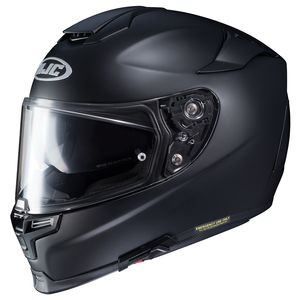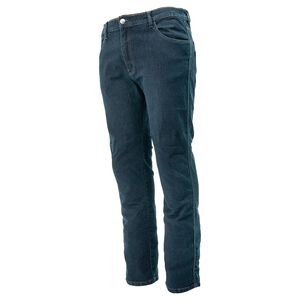It wasn’t easy handing the Chief Dark Horse’s keys back to Indian. It’s an outstanding cruiser that I would never buy, and for this one-tank review, I took it on a fantastic trip that I probably won’t repeat. Let me explain.
The new Chief line has three sub-models: the basic Chief, the flashy Bobber, and the touring-style Super Chief. Each of these bikes has a base model, plus an upgraded trim level with a smarter display, special finishes, and the Thunderstroke 116, Indian’s wildest air-cooled offering. If I had to buy an Indian Chief with my own money, I wouldn’t hesitate to choose the base Super Chief with its bags, ‘shield, and comfy touring ergos because it’s the model I would ride the most, no contest. But one of the best parts of this moto-reviewer gig is trying bikes I wouldn’t buy, or even test ride at a dealership, because the rational side of my brain says, rightly, that the Thunderstroke is best suited to schlepping rider(s) and camping gear on the long, happy journeys I’d like to take.
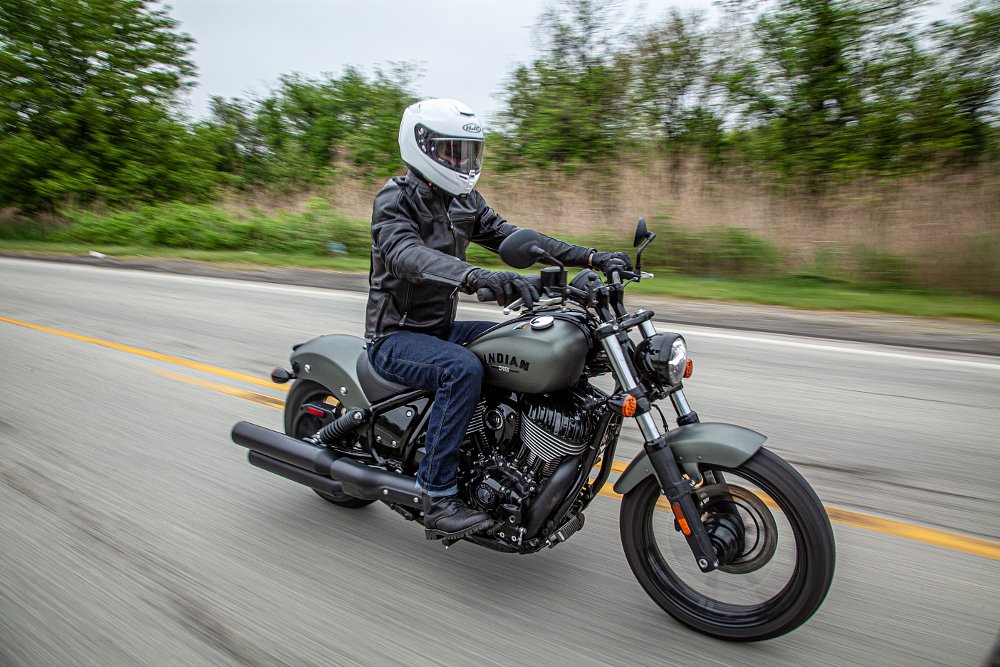
The Chief Dark Horse is the lineup’s inverse of that application. This bike wedges the largest engine into the lightest Chief model with mids, no bags, a bitty scoop seat, and a handlebar that's ready for the drag strip. My first mile of riding delivered a fine pair of hip cramps. I’m six feet tall with a fairly long reach, and even with that advantage, the riding position gives the impression that Indian fit the rider around the Dark Horse’s styling, and not the other way ‘round. It is a handsome machine when parked.
I found a better seating position (not that there are many options with the limited fore/aft distance) after a few miles on that first voyage and the riding experience improved considerably. The Chief is long, low, and wide in a way that recalls the Dyna-era Low Rider. The twin shocks only reinforce this comparison. These bikes are for the same sort of person, the rider who wants the full fat V-twin without all the baggage. This arrangement puts the torque directly in the bloodstream, where it has the headiest effect.
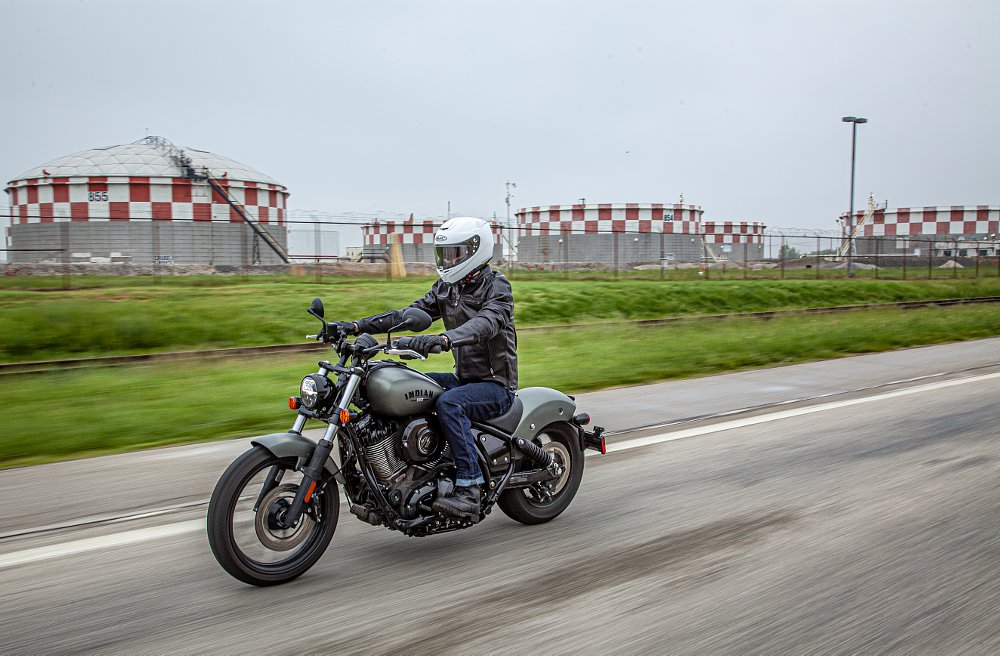
Spurgeon already covered the technical details and specifications of the Chief Dark Horse in his road trip review, so I won’t spend much time on the numbers behind this motorcycle, but for those who haven’t read that article, the essentials are: $16,999 ($17,499 for the upgraded paint on CT’s test bike), 120 foot-pounds of torque (claimed), 26 inches from saddle to blacktop, 672 pounds wet (claimed), and a wheelbase of 64 inches, which makes it tough to maneuver around a tight garage. Once rolling, it becomes a completely different machine. The Chief handles its weight admirably and I had no complaints about the factory-equipped Pirelli Night Dragon tires. Cruiser tires, like cruisers themselves, are misunderstood and overgeneralized too often.
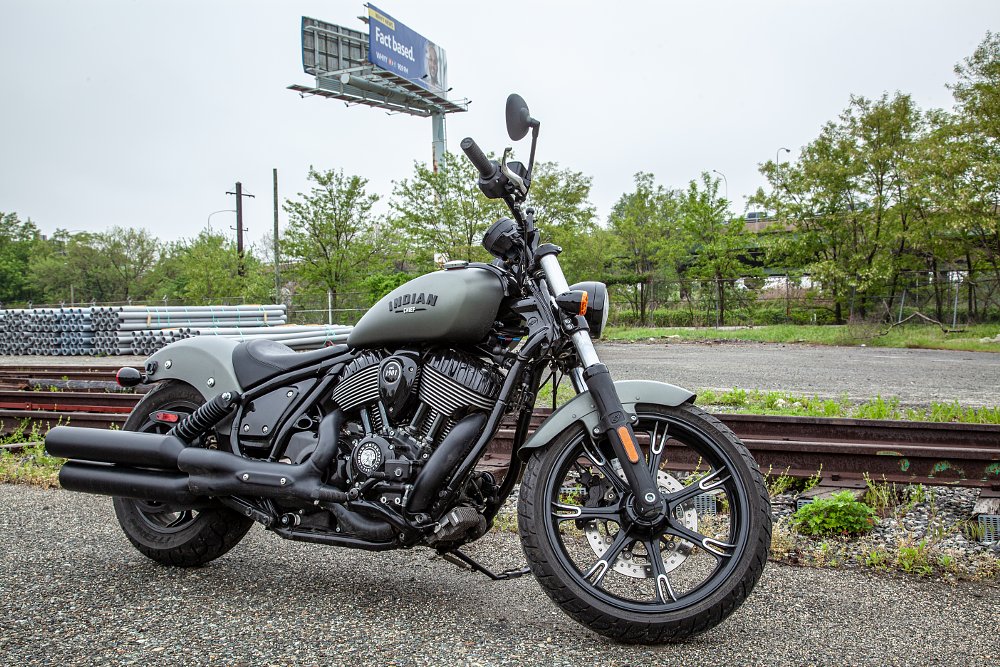
From a practical perspective, the Chief differs from the Bobber and Super Chief with its cast wheels, which means a puncture flat can probably be repaired with a basic plug kit. Food for thought if you plan on trips far from home, or live near a roofer. Let’s get back to the impractical perspective, however, and take the Chief on a short trip for which it seems purpose-built.
A different, luggage-free way to moto-camp
My grandfather rode his Indian Chief all over southeastern Pennsylvania many decades ago. There was no way I’d turn down a chance to ride the same roads on the new Chief, especially as Indian celebrates the model’s 100th anniversary. I’ve had a motorcycle camping trip idea rolling around in my helmet for a little while, a weekender fit for the rowdy Dark Horse and its cargo capacity of “whatever fits in your pockets.” I call it the Ten Pound Weekend Challenge.
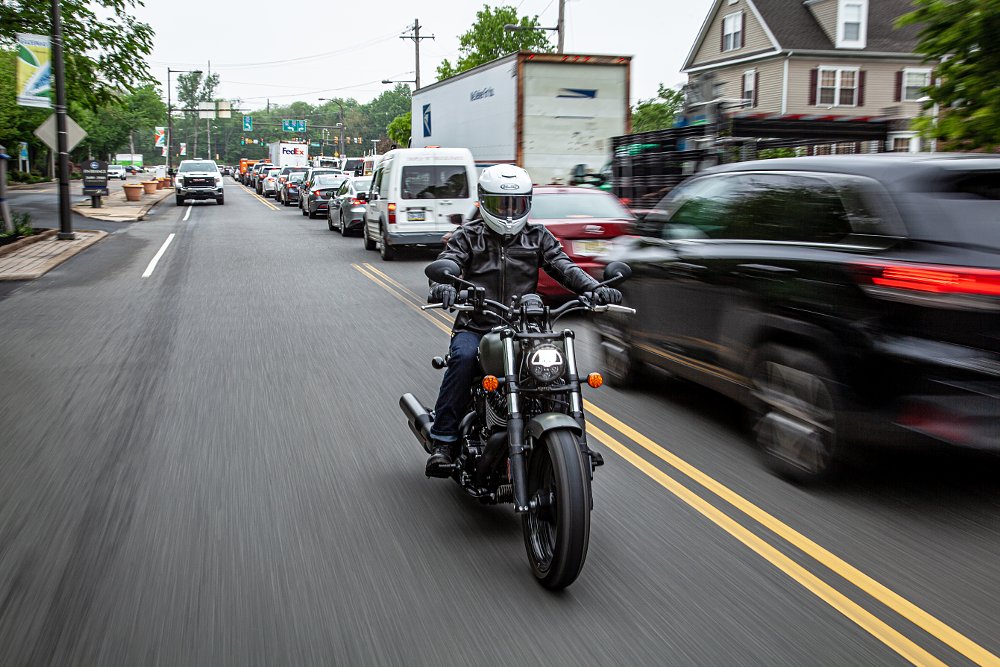
Loading a motorcycle up for a camping trip isn’t a big deal. Traveling light, as J.J. Cale sang, is the only way to fly, and modern camping gear can shrinky-dink itself down to fit almost any bike. There’s just one itch I can’t scratch: motorcycle camping with even less than I usually take. Some bikes want to be ridden as they are, without ROK straps, soft bags, or tents. Just once, give me a weekend, an unladen motorcycle, and a pack so light I don’t even notice it… I want 10 pounds of gear or less on my person.
That’s where services like Tentrr come in with upscale, fully equipped private campsites. It’s like AirBnB for camping. The sites always include large safari-style tents on wooden platforms, complete with Adirondack chairs, beds, benches, a table, water access, a primitive toilet, and a firepit. All you need is your essential gear and $60 to $130 per night. (Site prices may be different in other areas. That seemed to be the range here in Pennsylvania.) Some offer add-ons like blankets, fishing poles, kayaks, extra firewood, or even meals delivered to your tent by your host. I’m told this is called “glamping,” or glamourous camping. What better motorcycle for this trip than the opulent Chief Dark Horse?
All in, a Tentrr stay can cost as much as an average hotel if you’re glamping solo. I stayed on RevZilla’s dime, so that didn’t bother me much; most sites allow at least six people per site if you and your riding buddies want to split the cost. I found a site on a dairy farm outside Philly that looked just right for this one tank review.
Packing was easy. My summer sleeping bag takes up very little space in its compression sack, and that was the bulkiest thing I had to pack. I filled the remaining space with clothes, snacks, a dopp kit, an ultralight stove, and some coffee. Total weight was just over 10 pounds, or just under 10 once the coffee and snacks were gone. (Meals came from the surprisingly good local restaurants.) I’m calling that a success.
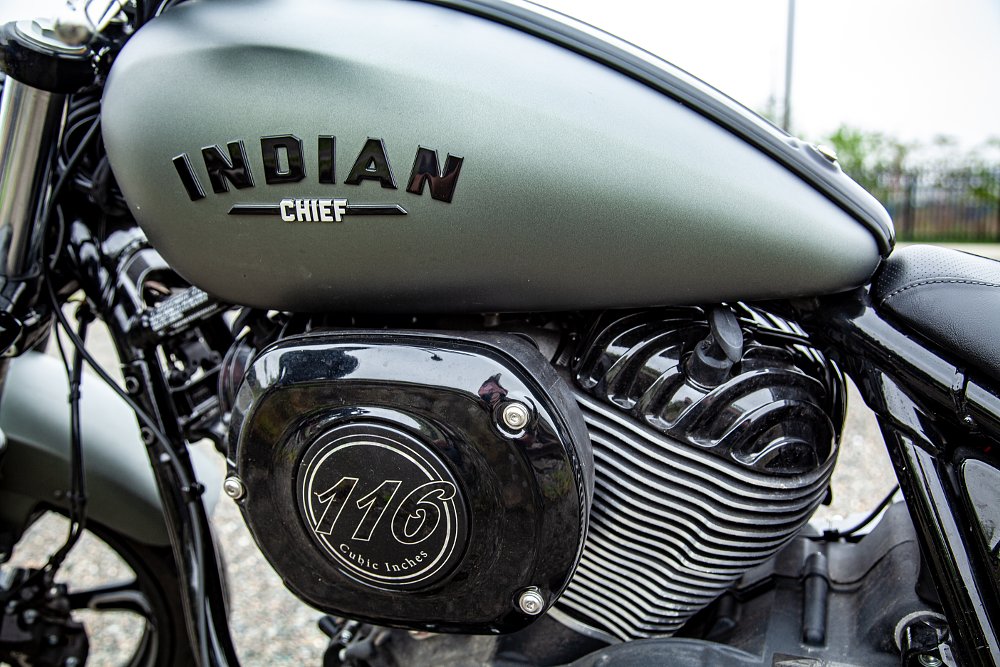
More importantly, the Chief’s beautiful matte “Alumina Jade” fender wasn’t burdened with camp paraphernalia. I’m not sure why you’d load a Dark Horse up like that when you can just buy a Super Chief, or any number of models from Milwaukee, built ready for travel right from the factory. The Chief Dark Horse focuses on two things: purifying the enjoyment of the Thunderstroke 116, and sheer style. I punched the site’s address into Indian’s excellent Ride Command display, which plotted a route that twisted into farm country without touching a toll route. The Dark Horse always felt best on three-digit county roads, anyway, with higher speed limits and quiet towns full of food and gasoline. Time to camp with the least effort possible.
Campward bound
Out on the road, the Chief’s engine is a real peach with all the torque you’d ever want, in any gear, at any speed right up to lose-your-license territory. Indian deserves special praise for its ride modes — too often, motorcycle ride modes are so similar that I can’t tell which one I’m using without a glance at the dash, whereas the Chief’s three personalities are dramatically different. Tour is so docile that you forget how potent those 1,890 ccs can be. Anyone could tame the Dark Horse in this mode. Then there’s Standard, which is smooth and punchy without the numbness of Tour. Spurg and I agree that this is the best of the lot. Sport makes no attempt to ease power delivery, making it quite a handful at low speeds. This mode is for blasting whatever’s next to you at a stoplight, the only form of motorsport this bike is likely to see, and the Dark Horse leaves hard. Other motorists may be surprised.
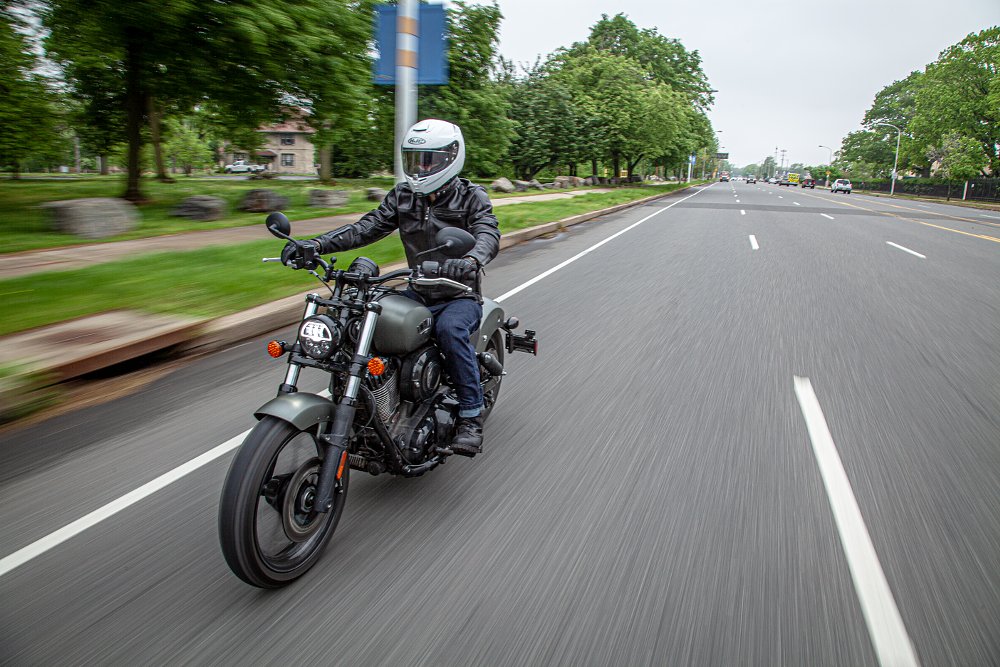
Sometimes I wondered if the engine would be more fun with fewer gears. Six-speed transmissions are the default these days, but does this lump really need half a dozen ratios to haul a solo rider and a backpack? The big Thunderstroke could get by with first, third, and sixth! I set the bike back to Standard and headed for camp, hoping to make it before dark. And if I didn’t? The LED headlight is one of the better examples I’ve used, so no worries there.
My brother decided to come along for the camping trip, except he brought a dual-sport instead of a cruiser after reminding me of this Tentrr listing’s description and its warnings of dirt access roads to the site, and potential water crossings if it rained hard enough. 4WD or AWD vehicles were encouraged. This would be a thorough test of the Chief, I thought, as I messaged the host to let him know when we’d be arriving.
Some miles later, a small sign pointed to a dirt lane that disappeared down into the woods. The dual-sport took a scouting mission and returned with the good news that there would be no water crossing today. The Chief was remarkably stable as I crawled down to camp, I’m happy to say. The biggest issue was turning this barge around on a doubletrack path. The engine’s torque and easy clutch helped with pointing the bike uphill to park by the short trail that led to the tent. I tossed my pack onto the cot and plunked down in a chair to bask in the lack of setup work.
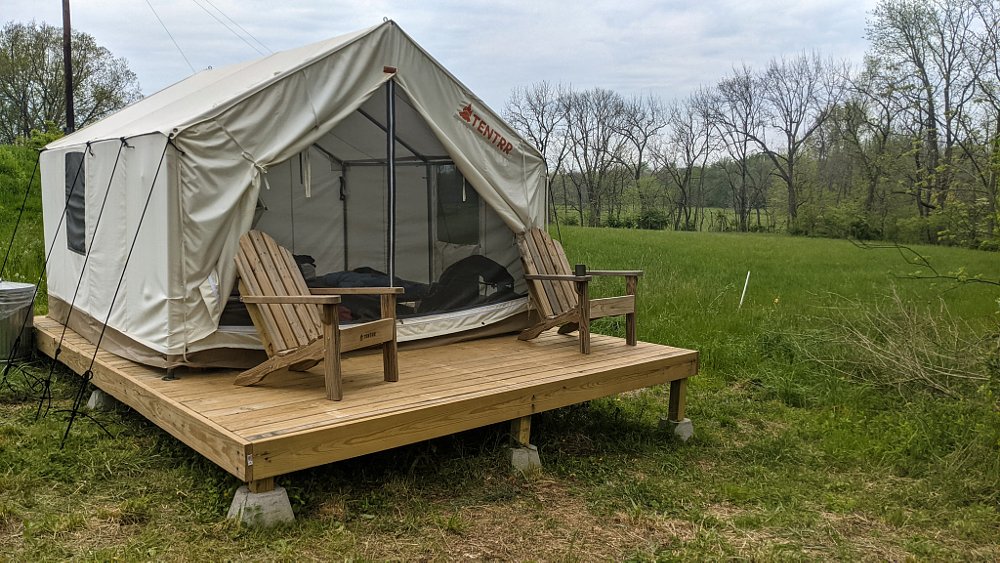
Don’t get me wrong, motocamping is one of my favorite ways to spend a weekend, and I don’t mind primitive camping for cheap or free. These glampers have a good thing going, though. No neighbors, no rooting around for firewood, and no sitting on my detached motorcycle seat by the fire because I didn’t have room to pack a camp chair.
Our host, Mark, came to check in on us and make sure that we had everything we need. The site was tucked away on a corner of the family farm that he operates, and the pride he felt for this land was contagious. He pointed to the dirt farm road and explained where we could find stacks of seasoned wood to burn, past the grazing fields he patrols with his old BMW airhead. Mark was impressed with the Indian, maybe for its appearance, or maybe for the fact that it was parked next to a DRZ in his woods. He said most of his Tentrr patrons were from dense urban areas like Brooklyn, though plenty of Penn’s Woods locals came through looking for an escape close to home. The socially distant nature of Tentrr rentals made for steady business in the long months of the pandemic.
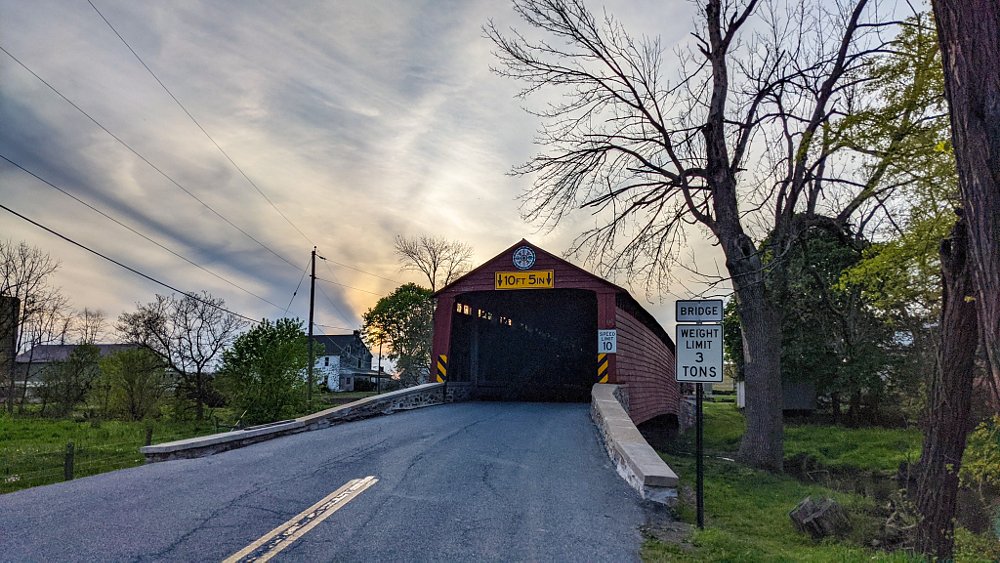
The largest tent I’ve ever stayed in was just along a creek that eventually joins the Schuylkill, after which it flows to Philadelphia to be polluted with street runoff, cheesesteak grease, leaking oil from mothballed warships, and most of the periodic table. But up here, the water was crystal clear and fully audible from the tent. We got a fire started, carried the chairs over, and queued up 1978’s Waylon & Willie. You know, I’d still prefer that Super Chief, but if I owned a Dark Horse, this is exactly what I’d be doing with it.
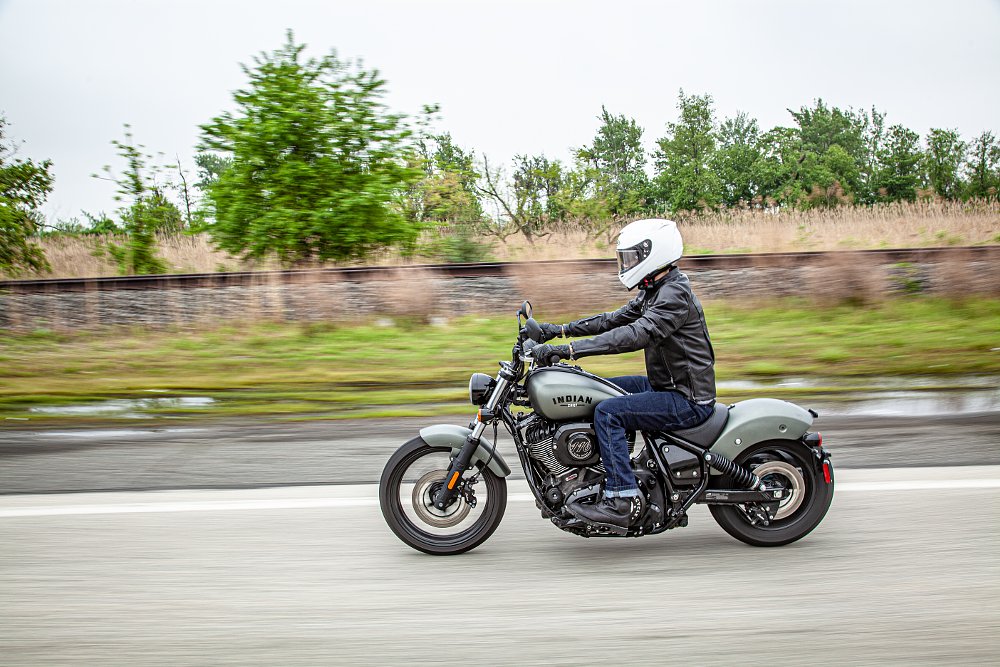
My major issues with the Chief were all ergonomic. I don’t fault Indian for this — no motorcycle fits everyone. I frequently adjust or change contact points (hand controls, foot controls, seats) on my machines. The Indian Chief Dark Horse, as delivered, was a poor fit for my body, but if I owned this motorcycle, I’d break out the wrenches and install these parts, in this order:
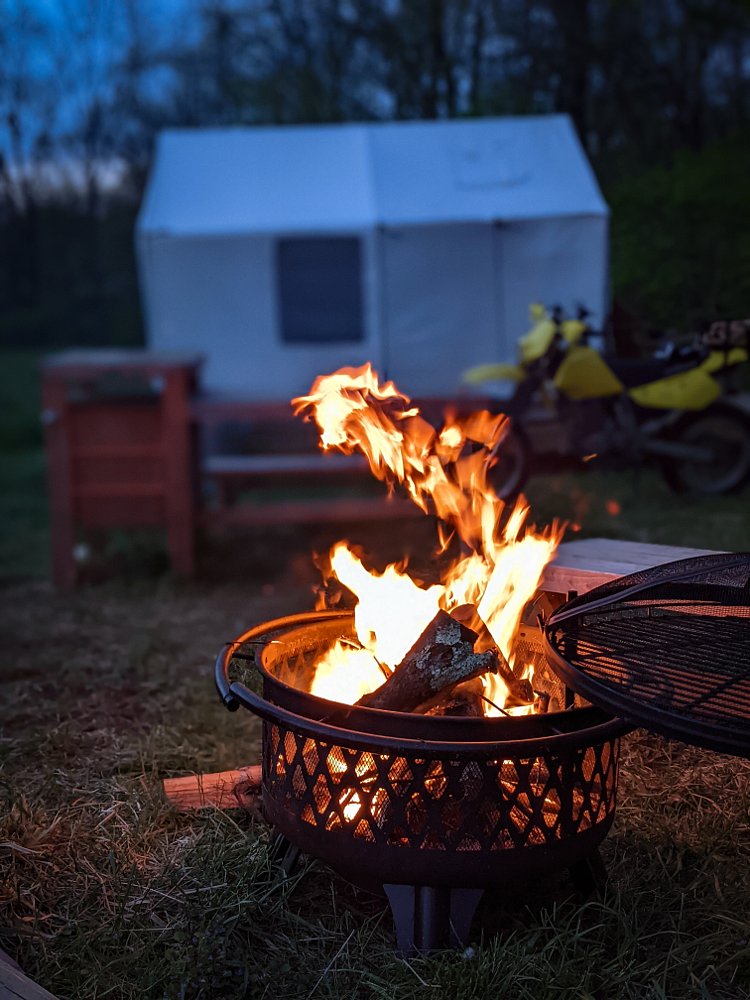
- Handlebar with more pullback, and maybe some more rise. The reach forward got my back after a few hours, and I’m a youngtimer.
- Different foot controls or highway pegs. Sorry, Spurg, I know you specifically wanted our Chief with mids, but I can’t fold my legs to fit this rider triangle for long rides. (See next mod.) My other issue here was the location of the brake master cylinder’s reservoir. On a few occasions, my right foot pressed on the reservoir cap instead of the brake. Not a big deal, I just wish it was mounted somewhere else.
- Taller seat. This saddle might work for a barhopper, or someone with a body type that’s much different from my own. I’d like the seat to be about an inch or two taller to buy some legroom and reduce my lean forward. The extra cushion might help the jolts from the back wheel when riding over sharp bumps and potholes. I suspect the angle of the rear shocks has something to do with that little problem for the Chief’s suspension, which I enjoyed otherwise. The engine and chassis are glassy-smooth on a rolling Pennsylvania road with reasonably intact pavement.
The bike’s monster torque and clean styling give the Chief what I feel are the essential benchmarks of its class. This Indian boogies when you’re riding it, and it delivers in the looks department, too, although motorcycle aesthetics are always semi-subjective.
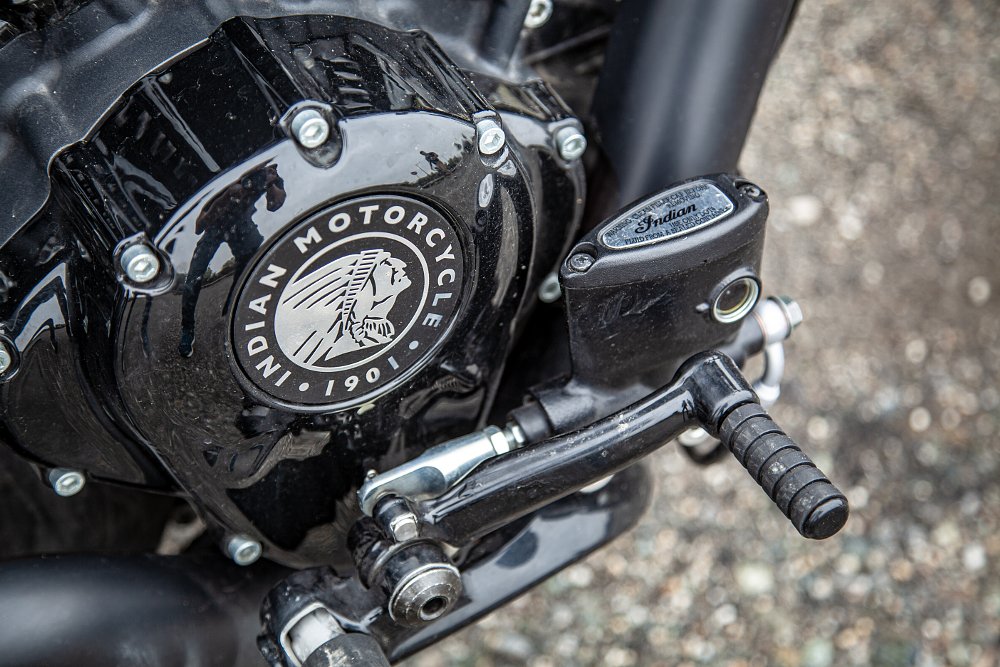
Final thoughts
I thoroughly enjoyed my time with this bike, from daily rides to my Ten Pound Challenge with Tentrr. Some bikes tell you how they want to be ridden, and the Indian Chief Dark Horse wants to stay as barebones as possible to viscerally connect the rider with the engine. The way the powerplant lopes and shakes at startup promises a very good time. My choice in the line remains the Super Chief, but it’s nice to know what would happen if I wasn’t rational with my hypothetical seventeen thousand dollars and bought this instead. Grandmom sure liked it when I stopped by with this one-man Fourth of July parade. I’ve never had a test bike earn such universal respect, if that matters to you.
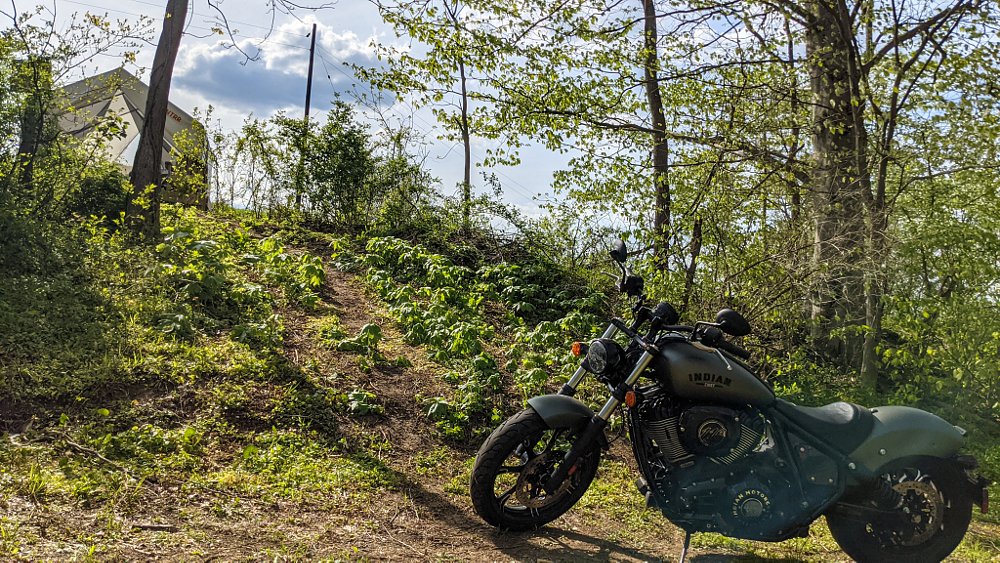
As for Tentrr, it’s a lot like the Chief Dark Horse: fun at a premium, and worth that premium if you’re looking for a specific experience. I’ll continue camping on a shoestring budget while I’m out by myself or cruising with the usual suspects. That said, I’d suggest Tentrr sites if I was taking a multi-day trip with four or more riders. The giant tent would make a solid base camp, and everyone’s happier if they can pack without their bulkiest items.
I know this is a one-tank review, but after running low, I filled it again, and again, and again, until Indian wanted it back.
|
2022 Indian Chief line
|
|
|---|---|
|
Price (MSRP)
|
$14,499 (base Chief), $15,999 (base Chief Bobber), $18,499 (base Super Chief)
|
|
Engine
|
1,811 cc (Thunderstroke 111), 1,890 cc (Thunderstroke 116), air-cooled, 49-degree V-twin
|
|
Transmission,
final drive
|
Six-speed, belt
|
|
Claimed horsepower
|
N/A
|
|
Claimed torque
|
112 foot-pounds (Thunderstroke 111), 120 foot-pounds (Thunderstroke 116) |
|
Frame
|
Steel tube with cast aluminum rear subframe |
|
Front suspension
|
46 mm fork; 5.2 inches of travel
|
|
Rear suspension
|
Dual gas-charged shocks, adjustable preload; 3.0 inches of travel
|
|
Front brake
|
Single four-piston caliper, 300 mm disc, ABS
|
|
Rear brake
|
Single two-piston caliper, 300 mm disc, ABS
|
|
Rake, trail
|
29 degrees, 5.2 inches
|
|
Wheelbase
|
64 inches
|
|
Seat height
|
26 inches
|
|
Fuel capacity
|
Four gallons plus reserve
|
|
Tires
|
Pirelli Night Dragon, 130/60R19 front (Chief), 130/90/R16 front (Chief Bobber, Super Chief), 180/65R16 rear
|
|
Claimed weight
|
670 pounds (Chief), 694 pounds (Chief Bobber), 739 pounds (Super Chief)
|
|
Available
|
April 2021 |
|
Warranty
|
24 months, unlimited miles
|
|
More info
|
|

 Membership
Membership

